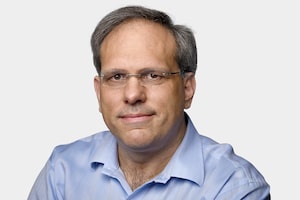Jonas Aqvist, chair of the Nobel Committee for Chemistry, Hans Ellegren, secretary-general of the Royal Swedish Academy of Sciences, and Olof Ramstrom, member of the Nobel Committee for Chemistry, announce winners of the 2022 Nobel Prize in Chemistry.TT NEWS AGENCY/Reuters
Three scientists, two based in the United States and one in Denmark, have been awarded the 2022 Nobel Prize in Chemistry, the Royal Swedish Academy of Sciences announced on Wednesday.
Carolyn Bertozzi, 55, of California’s Stanford University, K. Barry Sharpless, 81, of Scripps Research in La Jolla, Calif., and Morten Meldal, 68, of the University of Copenhagen share equally in this year’s chemistry prize.
All three are known for their contributions to the field of “click chemistry,” a versatile method of constructing larger molecules from smaller constituents. Their discoveries helped to usher in new approaches to drug development, among other applications.
“It’s all about snapping molecules together,” said Johan Aqvist, who chairs the Nobel chemistry prize committee. “Imagine that you could attach small chemical buckles to different types of building blocks. Then you could link these buckles together and produce molecules of greater complexity and variation.”
Remarkably, this year’s Nobel is the second for Dr. Sharpless, who previously won the chemistry prize in 2001 for unrelated discoveries. This time, he is being recognized for initiating the line of research into molecules that can snap together quickly and easily, like microscopic pieces of Lego.
It was Dr. Sharpless who first coined the term click chemistry when describing the process in a 2001 publication. He and Dr. Meldal both independently hit upon a key reaction involving copper atoms that underpins the click chemistry tool kit.
Meanwhile, Dr. Bertozzi hit upon a type of click reaction that can be used inside living organisms without disrupting biological function. The discovery allowed her to attach fluorescent molecules to other chemical components and then track their movements to reveal the action of those components within living cells.
Svante Paabo, decoder of ancient DNA, wins 2022 Nobel Prize in Physiology or Medicine
Nobel Prize in physics goes to trio of quantum researchers from France, U.S. and Austria
Speaking to journalists by phone immediately after the announcement, Dr. Bertozzi said she was “absolutely stunned” to have received the middle-of-the-night call from the Nobel committee informing her of her selection.
Dr. Bertozzi is just the eighth woman out of the 191 scientists who have been named Nobel laureates in chemistry since 1901.
The prestigious award, which will be handed out in a ceremony in Stockholm this December, is worth 10 million Swedish crown (about $1.24-million).
Until they are announced, the names of those who have been selected by the Nobel prize committees are a closely guarded secret.
This year’s list of winners defied the expectations of those who thought that the inventors of mRNA vaccines for fighting COVID-19 would be recognized with a Nobel in 2022. The vaccines could instead be the focus of a future Nobel announcement in the medicine or chemistry category.
Jean-François Morin, a professor at Laval University in Quebec who employs click chemistry in his own research, praised the committee’s choices this year.
He said the work of the three prize-winners paved the way for a type of chemistry that reduces unwanted side reactions and toxicity.
In the future, he said, “I can see researchers in many areas like pharma and materials using these efficient reactions to prepare molecules without producing chemical wastes,” and in low energy conditions.
Jean-François Morin, a professor at Laval University in Quebec who employs click chemistry in his own research, praised the committee’s choices this year.
He added that the work of the three prize-winners paved the way for a type of chemistry that reduces unwanted side reactions and toxicity.
In the future, he said, “I can see researchers in many areas like pharma and materials using these efficient reactions to prepare molecules without producing chemical wastes,” and in low energy conditions.
A number of researchers with connections to Canada have previously taken home the chemistry Nobel. The first was Ernest Rutherford, a New Zealand-born pioneer in the study of radioactivity who won the Nobel in 1908, one year after leaving McGill University in Montreal, where he had conducted much of his prize-winning research.
Gerhard Herzberg, a scientist with the National Research Council in Ottawa, received the prize in 1971 for work in the field of atomic and molecular spectroscopy. Fifteen years later, John Polanyi, who is a professor emeritus at the University of Toronto, took home the award for discoveries related to chemical kinetics. Then Michael Smith, a biochemist at the University of British Columbia, won in 1993 for his studies related to mutations in DNA.
Other chemistry Nobel laureates who were born in Canada but did their Nobel-winning work elsewhere include William Giauque (1949), Henry Taube (1983) and Rudolph Marcus (1992).
Wednesday’s announcement rounds out the three science Nobels for this year.
On Monday, Svante Paabo, a geneticist who specializes in the recovery and analysis of ancient DNA, won the prize in physiology or medicine. On Tuesday, three researchers known for their work in quantum information science claimed the physics prize.
Recipients of the Nobel Prize in Literature and the Nobel Peace Prize are set to be announced on Thursday and Friday, respectively. The announcement of the winner of this year’s Nobel Memorial Prize in Economic Sciences will take place on Monday.
 Ivan Semeniuk
Ivan Semeniuk